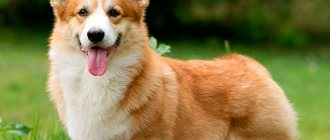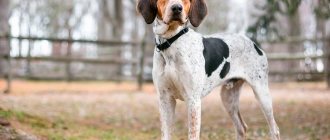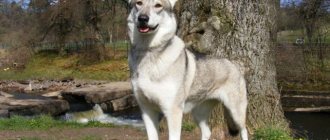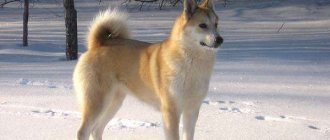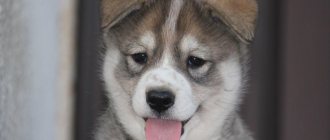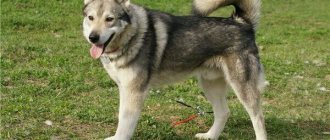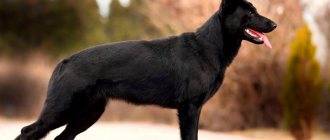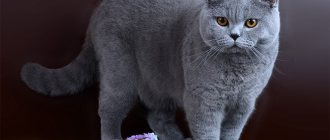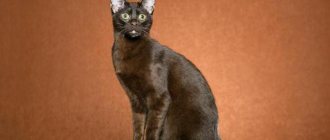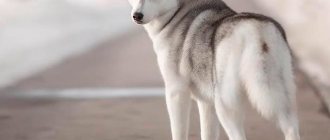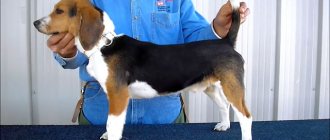The black and tan color is characterized by the “superposition” of tan markings on a basic black background. Areas of red pigmentation are always located on the extreme parts of the body (mouth, lips, cheeks, eyebrows, throat, two marks on the chest, paws, front of the thighs and anus). These marks are always located in the same places, but in some breeds they can spread over a slightly larger area.
Black color can be replaced by brown, blue or beige, and red color can be replaced by sand. It is not difficult to formulate the name of the color in these cases: for example, black with sandy tan, brown with red tan, etc. Please note that the four varieties of dark colors found in Dobermans and other pinschers, as well as the rare beige and sandy tan color (in traditional nomenclature - "Isabella"), with the exception of variants with blue and beige backgrounds, are currently prohibited from use in breeding due to problems arising from “weakened color syndrome”.
There are, although rare, colors in which the red (or sand) markings are covered with brindle stripes. In such cases, the color can be described, for example, as “black and tan with brindle.” Black and brindle is a black and tan color with brindle markings. In some breeds (Cane Corso) the dark brindle color is called black and brindle.
In addition, “blackening” may be present on the tan (especially on the forelimbs). The presence of such blackening is most often regarded as an undesirable sign.
Sometimes there is a red color with blackening with red markings on the extreme parts of the body. It is classified as "fawn with black and tan" and is quite common, for example in wire-haired dachshunds.
In some breeds of hunting dogs, the so-called “light tan” is considered a desirable trait. The color is black with sandy tan.
And finally, this type of color can be combined with a mask. This species can be identified by the dark (no markings) color of its muzzle.
In black and tan poodles, the color is called phantom.
Caramel color (in East Siberian huskies) is a black and tan color in which the black dog has whitish or reddish tan on the legs, chest, cheeks and eyebrows. This term has been known since the late 60s. XX century (Geitz, 1968). It is believed that it came from the name of the village of Karam, Kazachinsko-Lensky district, Irkutsk region, from where black and tan huskies were brought to the Irkutsk nursery for hunting and hunting dogs, which became the founders of the first factory lines (Geits, 1968; Kruzhkov, 1985). In addition, the closeness of the sound of the word “karam” to the Evenki “kara” (“black”) and “karame” (“dog name”) (Boldyrev, 1994) suggests an even earlier origin and Evenki roots. One way or another, this term has firmly entered the lexicon of VSL lovers, has become widespread, and has become the calling card of the breed throughout the country and abroad (foreign lovers of East Siberian Laikas use “karamis”).
Breeds in which these colors are found: Beauceron, Rottweiler, Swiss Jurassic Hound, Doberman Pinscher, Wirehaired Dachshund.
With the saddle coat color, the dog has a dark back, with black, gray or brown color evenly descending onto the sides, forming the so-called “saddle blanket”. Legs, muzzle, belly are red. The most typical, “classic” black-backed color is found in Airedale and Welsh terriers, as well as German shepherds, many bloodhounds, beagles, etc. The color can vary greatly, the dog can be almost black or with traces of red on the legs, under the tail and faint yellow points above the eyes. Sometimes the saddle coat can be so small that the dog looks almost red with a dark stripe down the back. Such dogs are common among Russian hounds. Among German and East European Shepherds, dogs of this type may appear zoned gray. In some cases, the black saddle color can look almost tan.
It should be noted that the question of the presence of separate genes responsible for the development of tan and saddle-back colors is controversial. So, for example, K. Little considers the sable color as the result of the combined action of tan genes and modifier genes.
Such a wide range of variations in black-and-white color is also associated with the action of modifier genes. In some breeds that have a solid color, individuals that are heavily camouflaged saddlebacks are bred. This is occasionally observed, for example, in black terriers, descended from Airedale terriers and Rottweilers. Dogs that are carriers of the normal tan color have long been withdrawn from breeding. Gene frequency a t
in their population is reduced to a minimum. The black-and-white color genes, heavily disguised by the corresponding modifiers, periodically remind themselves of themselves, appearing in a homozygous state. Externally, a similar modification of the black-backed color can manifest itself in a slight lightening of the ends of the paws, points above the eyebrows and hair around the anus. Constant crossing of such individuals with dogs that have a solid color contributes to the accumulation of modifier genes that bring the saddle color closer and closer to the solid color. If the frequency of such alleles in a population is low, such individuals may not be culled from breeding.
In many breeds both alleles occur. Alleles a t
a t
contribute to the development of a normal tan color with a clear pattern.
Alleles a s a s contribute to the development of a modified tan pattern, sometimes accompanied by severe darkening. Blackened tan marks are noted as a vicious color even in Doberman Pinschers, which are an example of the “classic tan.” Sometimes the tan pattern boils down to lightened ends of the paws, the presence of light dots above the eyes and a light spot around the anus. Occasionally, lightened areas begin to be visible only at the age of 2-3 years, so the color of such dogs is sometimes mistakenly identified as black.
Color groups
Experts divided all the variety of colors into several main groups. They include both single-color and multi-color variations of shades and patterns.
Solid
The solid color of tetrapods is distinguished by the presence of only one shade on their body. On the other hand, it may be its complete absence. The substance eumelanin forms black or chocolate pigmentation with varying degrees of saturation. The lightened form of this type is called blue or beige.
The substance pheomelanin is responsible for the red or deer variant. And the lightened form of the pigment gives a sandy background with variations from white to light cream.
Mixed
A mixed group appears by combining a pair of shades. Moreover, the white tone should not participate in the mixing. The variation in the colors of the dog is influenced by the presence of the substance eumelanin or pheomelanin. As a result of the manifestation of these two pigments, 5 types of mixed tones are distinguished:
red with a black mask on the face;
red with some darkening;
Character Traits of a Black Spitz
Black Pomeranians have a lively, active and inquisitive character. They love to play and run, they are smart and quick-witted, so they are easy to train and become loyal friends for their owner.
Pomeranians' ancestors were guard dogs, and genetically determined traits show up in their diminutive descendants. Tiny German Spitz can come into conflict with large dogs and will not miss the opportunity to bark at a stranger who happens to be on their territory. Despite this, they get along well with other pets, including cats. True, the puppy must be raised correctly, otherwise it will become wayward and sometimes aggressive.
Single-color dog colors with shade names
Individuals of the same color are found in different breeds. There are quite a lot of them, so they delight you with rich tones and interesting solutions. Specialists in the selection and breeding of four-legged animals have created a classification of individuals with uniformly colored fur.
All monochromatic representatives are divided into:
Dark
, which are influenced by the substance eumelanin. The saturation of the dog's color depends entirely on the concentration of this pigment. A high content of eumelanin was noted in dark brown and black individuals. Some breeders say that there is no such thing as a black dog, but that it is simply a highly concentrated shade of dark brown.
Svetlykh
, whose fur was colored with pheomelanin. A high concentration of this element in the hairs of the animal gives them a yellow and deer tint. A slight pigmentation with pheomelanin makes the pet's fur sandy.
Reds
, which include light reddish and deep red coats. The main tone of this option is red. The mahogany look is now popular, incorporating the brightness and richness of red.
Apricotsovs
, which are considered just an intermediate step between cream and red options. This species has some degree of whitishness and is distinguished from the red one by inclusions of light hairs.
Blue
– this option includes silver and gray fur. Individuals with blue fur are distinguished by an ash-light or dark shade.
Isabellovs
, or weakened brown. This is a pinkish-cream version with gray or blue tints. The variant is obtained by mixing blue and red colors.
Belykh
individuals who received such a coat at birth. Snow-white pets have black or brown noses and lips.
Palevykh
, having a lightened red color. The fawn color of dogs can have different shades. Thus, the area of the chest, paws and the lower part of the tail can be almost white, and the mask on the face, on the contrary, is dark or even black. Fawn-colored dogs differ in the tone of their nose: it can be pink, brown or dark.
This classification of monochromatic individuals gradually becomes more complicated, supplemented by other options. So, recently they began to talk about albinos, whose fur looks snow-white. In fact, the fur coat of albinos is colorless, and the lips and nose of the unusual animal are painted white. In nature, there are very few true owners of such wool.
Genetics
Breeders have long studied the process by which color and pattern are formed on the coat of an animal. Coloring depends on genes, including those responsible for the pigment and structure of the hair. If mixing occurs, the genes begin to form the color of the dog.
There are several coloring genes.
- C. It is a key component in the entire gene chain. Due to it, the body is able to synthesize all color options. The peculiarity of this component is that it has no color. If it is not present in the body, the puppy may be born with an albino coat. However, even if there is no such gene, the nasal mirror and iris can still become pigmented.
- A. Responsible for the distribution of color throughout the coat. With its help you can get a solid color or sable.
- Q. This is a black gene that dyes hair a dark tone. A breed such as the Giant Schnauzer or Newfoundland must have it. Other types of breeds may have inclusions of such a gene, which will manifest itself as tan or zoned colors.
- D. It is responsible for the richness of the black color. If the gene is weakened, the coat will be lighter, resulting in the animal having a blue pigment. This may affect the dog's vitality. If a baby Toy Terrier or Doberman is born with the recessive D gene, he will receive blue pigment and in most cases will not live to old age. If the gene is dominant, the coat turns out dark and provokes the correct form of melanocytes (pigment cells).
- E. It harmoniously arranges the pigment of black, brown and yellow. With its help you can get solid colors or tri-colors.
- G. It is called gray because it helps lighten the coat as the animal begins to age. Often a dog can be born blue, evenly changing the color of the coat.
- M. This is a marble color. He gives not only the famous harlequin drawing. In its homozygous form, the gene can lead to a congenital anomaly of the fetus. Often a gene can be classified as a modified color because it can also become lighter as it ages.
Two-color varieties
The combination of two different shades on the body of a four-legged friend allowed breeders and zoologists to talk about a large number of variations. These include quite common types, and those combinations that are difficult to find on an ordinary dog.
Tan
The main tone of this option is gray, brown or dark. The tan color of dogs is distinguished by light spots that sharply border on the main tone. Tan is located on the eyebrows in the form of two spots, on the cheekbones, throat and chest area. There are lightened areas on the muzzle, but in this case the bridge of the nose has the main pigmentation. Tan marks can be seen on the front of the animal's paws, around the anus, and on the bottom of the tail.
Zonar, or wolf
The zonal or wolf version of the two-color color has a light background. At the same time, in certain areas of the animal’s body, yellow, black and lightened areas are clearly visible.
Cheprachny
The basis of a dog’s saddle fur is a red pigment, which gives the pet’s fur coat different shades - from bright red to light fawn. In addition, black or gray becomes the main tone.
The sable color of dogs differs in size and tone. Most often, darker areas are located on the upper part of the animal’s body: on the head, shoulders, back, tail. Lighter pigmentation occurs on the lower jaw, cheeks, throat, chest, and belly.
Sable
The coat of pets with the sable color variant is characterized by a predominance of a reddish tint of varying degrees of saturation. The ends of the hair of such representatives contain a special pigment that colors them black.
brindle
The brindle color in dogs appears as transverse dark stripes on brown or sandy fur. The body of the animals is painted in warm shades: yellow, red, red. There may be gray fur, but it is very rare.
Sometimes the presence of whitish points is noticeable, which is not considered a flaw. The stripes on the dog's body look like rings that break on the stomach. A dark, almost black mask is often visible on the face of a tiger pet.
Murugiya
This option takes as a basis a dark red shade, which varies, reaching the darkest color of mahogany. The ends of the pet's hair are covered in a dark, almost black tone. The nut color, which is called fawn, is also found here. It can range from light sandy to dark golden in tone. Redness is not typical for this species.
Combing
You need to comb your pet correctly, as its coat has a very long and thick undercoat. The undercoat supports the guard hairs, which provide color and shape.
Scheme of direction of movements during combing
Combing is carried out carefully, after spraying the surface with special products or water. Comb in the direction from the stomach to the back, against hair growth.
Grooming kit
Combs should be soft, massaging, with fairly sparse teeth. The tail is combed from the base.
Bathing
The breed does not require frequent bathing. It is advisable not to bathe more than once every two months. Frequent bathing leads to degreasing of the skin, drying it out, which later leads to problems.
Well-groomed coat of a tan orange
Breeders' bathing tips:
- Wash only when clearly soiled; if brushing regularly, use dry shampoo to cleanse the coat.
- Bathe using special moisturizing shampoos and conditioners for dark coats.
- Dilute the shampoo with water immediately before applying to the coat according to the instructions on the package. When applying shampoo evenly to the coat, try not to tangle it.
- Don't bathe your dog more than once every month or two.
- After bathing, dry the wool only with a hairdryer; using a towel leads to the formation of tangles in the wool.
Important! During shedding, the coat must be brushed frequently, but bathing is absolutely prohibited. Fallen, wet hair will form tangles, and bathing itself will be painful for your Spitz.
Wool products
For Charcoal Spitz, it is important to use special cosmetic cleansers that can improve color. Here are a few examples of special tools.
“Chris Christensen Shampoo Black on Black” for a black Spitz, cost 1,530 rubles. for 0.4 l.
Cosmetics
The shampoo cleanses well and at the same time gives the hair a rich dark color. Suppresses red tint.
Starter kit for dogs “Chris Christensen”, cost 1020 rubles.
Starter kit for dark dogs
Set contents:
- shampoo “Black on Black” - 118 ml;
- protein foam - 118 ml;
- after bath balm - 118 ml;
- spray “Ice on Ice” - 60 ml.
How to use:
- Apply undiluted shampoo to damp hair, whip into foam, leave for 10 minutes and rinse.
- Apply foam to clean, damp coat after shampooing, leave for 3 minutes and rinse.
- Distribute the “after bath” conditioner balm over the coat and rinse thoroughly.
- Before styling, spray with spray, dry well and comb.
“Pure Pause Black Magic” - shampoo with optical glitter, price 2,900 rubles.
Pure Paus Black Magic
Available in concentrated form. Apply, after diluting with water, 1 part shampoo to 8 parts water. Thanks to the optically shiny scales, the coat looks healthy and the color is rich. After applying to the coat, leave for 2-3 minutes and rinse thoroughly. Following the shampoo, use Black Magic conditioner, which protects the coat from fading and exposure to sunlight. The air conditioner costs 2,800 rubles.
Shampoo No. 18 For Black Wool (USA), 250 ml - RUB 2,850.
Does not contain coloring pigments. Enhances color. After use, conditioner must be applied.
Wonder Wash - dry shampoo that does not require rinsing, RUB 1,650. 500 ml.
Shake, spray, rub in and comb through fur.
Diet
Black wool requires care when feeding. The best advice is to take references from the puppy's breeder. The food can be natural or professional. It is necessary to carefully study the composition of the feed and the possible impact of the products on coat color. Many products tend to color the coat, giving a reddish, brownish color.
Kleinspitz
Important! Even professional food can cause coat coloring.
To understand why the fur has changed color, for example turned brown, look at the hairs. If the hair is brown only in the upper third of the hair, external factors such as UV rays are possible, and if the hair is completely brown, then most likely these are consequences of the food consumed. If your pet has brown spots only around the mouth and on the paw pads, then these may be signs of an allergic reaction. In any case, you should contact a specialist.
Nutritional supplements to improve pigmentation
To improve black pigmentation, there are various nutritional supplements such as vitamins. They improve the quality and color of wool.
GAC Seealgenmehl is a feed additive developed specifically to improve dark coloration. Costs 760 rubles. per 200 g, consumption - 0.5 teaspoon per day.
Appearance of Seealgenmehl supplement packaging
Winner Plus B-Plus is a food supplement for enhancing pigmentation.
Appearance of the packaging of the dietary supplement Plus B-Plus
It also pigments the nose, lips and eyelids darker. 620 g costs 750 rubles, consumption is 1 g per 2 kg of pet’s body weight.
Types by location of spots
The appearance and location of the marks on the dog’s body differ in intensity and size. They can cover almost the entire body of the animal or concentrate in certain areas. Dogs with spots on their coats come in most breeds. Based on the location of the spots, they are distinguished:
Irish spot with white markings of varying sizes that cover most of the animal's body.
Piebald, in which there are large white areas on the head, neck, chest, tail and paws against a dark background.
Extreme spotting with a small amount of primary color pigment. Sometimes the pet appears white with small colored areas.
Speckling, when many small spots are visible on a white or light gray tone, the color of which depends on the main color of the dog.
Marble with black spots of irregular geometry and different sizes on a white base.
Some breeds begin to develop a spotted pattern as they age. For example, the fur of Dalmatians only after two months of life becomes similar to the standard exterior that is familiar to people. Sometimes the appearance of spotting is associated with deviations from the characteristics of the breed.
Three-color variations
A tricolor dog acquires its color as a result of a mixture of tan or saddleback species combined with black or red spots. Moreover, the marks are placed in strictly defined areas of the body, and not in a chaotic manner. Among these variations are:
- Roan
, the peculiarity of which is the location between pigmented hairs of non-pigmented (that is, white). This combination creates a silvery background with some weakening.
- Marble
, or "Harlequin", with a white, blue-gray or light base. The dog has black spots with jagged edges. Sometimes the marks may have a brownish-gray tint.
- Piebald
, which is a combination of two bases. This option appears in large light or white spots. They are located on a reddish background. In some cases, the base tone has a different pigment.
The names of colors vary among different breeds. These may be traditional specific names. There are also special names for the colors of hunting animals, which have historically developed and become entrenched in the everyday life of lovers of four-legged animals.
Varieties of face masks
Different breeds of four-legged animals differ not only in the color of their coat, but also in other features of their exterior. Thus, on the dogs’ faces you can see masks characteristic of the breeds.
They are dark - brown or gray. Masks may vary in size and extend to the chest. The marking is combined with a variety of bases: zoned, saddle, tan and brindle. And among greyhounds the mask is called “mazurina”.
Reverse masks are light areas on the dog's face. May be called domino or grizzly. The reverse mask is combined with zonal and saddle tones.
Basic rules of care
Huskies do not require labor-intensive coat care or, for example, haircuts or trimming. It is enough to brush these dogs twice a week, however, when the pet sheds, this procedure will have to be done at least daily.
Black Huskies are bathed as needed and no more than 1-2 times a year, and it is recommended to use dog detergents.
The pet's ears and eyes need to be examined every day and, if dirty, cleaned using special products in the form of drops or lotions purchased at a veterinary pharmacy.
Husky claws are usually quite hard and therefore may not always grind down on their own when walking on hard surfaces. As soon as the dog begins to click on the floor with them or the tips of the nails bend down, they need to be shortened using nail clippers for large dogs.
IMPORTANT!
If black huskies have plaque on their teeth that the dog cannot remove on their own, it is recommended to clean them with a dog toothbrush with a special toothpaste applied to it.
The rarest types and tones of dog colors
There are rare color variants that are found only in some breeds. For example, Blenheim combines the mottled hue of rich chestnut with a pearly white background. This type of coat is typical for Cavalier King Charles Spaniels. This breed has a white diamond-shaped pattern on the crown of their head.
Pit bulls, bull terriers, corgis, Aussies and other breeds have a rare type of color called merle. This is uneven pigmentation of the coat. Merle appears as a combination of the same dark or light background.
Merle is rare, since the gene responsible for this coloring carries deviations in health. It is prohibited for breeding in most breeds.
Origin of the Black Pomeranian breed
Pomeranians originated in a region of Germany called Pomerania. At first these were large dogs that were used for protection, but after a while representatives of the nobility paid attention to them. Queen Charlotte, who married George III, brought a puppy with fluffy fur with her, which began the history of breed selection.
It is difficult to determine what color the ancestors of modern Pomeranians had, but the most common is considered to be a red tint - from fawn to brown. The color depends on a set of genes that determines the presence of a certain pymentum in the hairs - the charcoal shade is caused by a substance called eumelanin.
Individuals of uniform color are cultivated separately. To do this, babies are selected from litters that meet the necessary conditions, and then they are crossed with each other.
Sometimes genetics presents surprises to breeders - it is impossible to accurately predict the color of the fur of newborns.
Genetic conditioning
The appearance of the fur of tetrapods is determined by different genes. Some of them are responsible for the fusion of the substances eumelanin and pheomelanin. Other genes distribute these elements throughout the pet's coat and body.
There is a hereditary predisposition that determines the intensity of the basic tone and spottiness of the fur. The main genes responsible for the tone of the coat are genes A, C, B, D, E, G, M.
Their combination forms the color and pattern on the body of the four-legged friend. Genes are able to combine in different combinations, distributing pigment and spotting throughout the body. Experienced breeders, having seen the parents of the future puppy, are able to calculate the baby’s exterior, even if he is still in the womb.
The standards of some breeds contain strict rules on genetic conditioning. For example, in Europe there is a ban on dogs with Isabella color. This variant contains a combination of genes that subsequently provoke a whole range of diseases.
How coat color changes with age
Experienced owners and breeders know that the appearance of some pets' coats changes over time. For example, if a puppy was born brown, then the tone darkens with age.
Sometimes these changes are indicated by the nose. If it is darker than the main background of the coat, then over time the fur will become darker. Owners of the following breeds experience similar discoloration:
- Rottweilers acquire a bright tan color as they age. Sometimes black specks become noticeable.
- German Shepherds are born tan but become black over time.
- Dalmatians are born completely white, and from 2 weeks they begin to acquire spots. By two months, the Dalmatian turns into a dog with black spots.
- Kerry Blue Terriers initially have a black coat, but after a while the silver pigment appears.
In addition to the listed breeds, changes occur in the exterior of the Yorkshire Terrier, Bobtail, and Spitz. Sometimes an unexpected pigment change occurs. Such changes do not affect the loss of characteristic breed standards, because they are provided for during the breeding and further sale of grown-up puppies.
Also, one cannot discount the simple gray hair that appears in older individuals. Due to it, the color is slightly lightened, and sometimes reaches a piebald shade.
In general, the dog’s appearance is influenced by the genetic predisposition of the breed, as well as the mixing of the colors of the parents. Over time, your pet's appearance changes due to age or characteristics.
Dogs can surprise with their colors, thereby winning the hearts of fans. However, everyone should know that dog colors are classified into groups, each of which has different characteristics.
Verification of documents
The best proof of a puppy's thoroughbred are documents for the parents and for the baby himself - a certificate of origin of the dog, with date of birth, color and name. The documents will be confirmed by a stamp on the inside of the puppy's hind paw.
When choosing a German Shepherd puppy, it is advisable to undergo a comprehensive check, taking into account all the nuances of the breed. This will allow you to protect yourself from all sorts of fraudulent tricks of the breeder and adopt a worthy representative of your kind.
Sources:
https://thedifference.ru/kak-otlichit-nemeckuyu-ovcharku-ot-dvornyagi/ https://dogcentr.ru/voprosyotvety/pomogite-uznat-porodnost-nemeckoj-ovcharki.html https://gafki.ru/sobaki /kak-opredelit-schenka-nemetskoy-ovcharki-ot-dvornyagi.html
Causes of acquired clubfoot
Changes in the shape of the paws and gait disturbances are sometimes caused by poor nutrition or unbalanced physical activity.
As a rule, such symptoms are characteristic of acquired pathologies:
- X-shaped and O-shaped deformation of the limbs is a consequence of an improper diet. Excess protein in food stimulates active growth and weight gain. The puppy’s bone structures are not strong enough, they are bent. At the initial stage, treatment is limited to reducing the amount of protein consumed, but in case of severe deformities they resort to surgery.
- Rickets is a chronic disease caused by a calcium-phosphorus metabolic disorder. Develops in pets with a lack of vitamin D, calcium and phosphorus. Associated symptoms include stiffness of movement, muscle tension, and a saggy belly.
- Secondary nutritional hyperparathyroidism is a deformation of bone structures caused by a lack of calcium with excess calories. It occurs in pets fed high-protein foods without calcium supplements.
The cause of clubfoot is also increased physical activity. During growing up, they need to be increased gradually.
Diagnostics
Your veterinarian will take x-rays of the entire limb, including the elbow joint, to compare bone lengths and determine whether the muscles of the elbow joint are attached.
Other signs your veterinarian may look for on x-rays to confirm a spinal deformity are enlarged bones, inflammation of the entire bone structure, and muscle spasms.
Preventive recommendations
It is recommended to cover the floors with carpet. This will help your puppy's weak legs gain strength. An animal that stands well on its feet does not show signs of discoloration.
If it is not possible to replace the floor surface, then you need to walk your pet daily along:
- small crushed stone;
- sand;
- deep snow.
It is advisable to walk the puppy on the sand every day.
